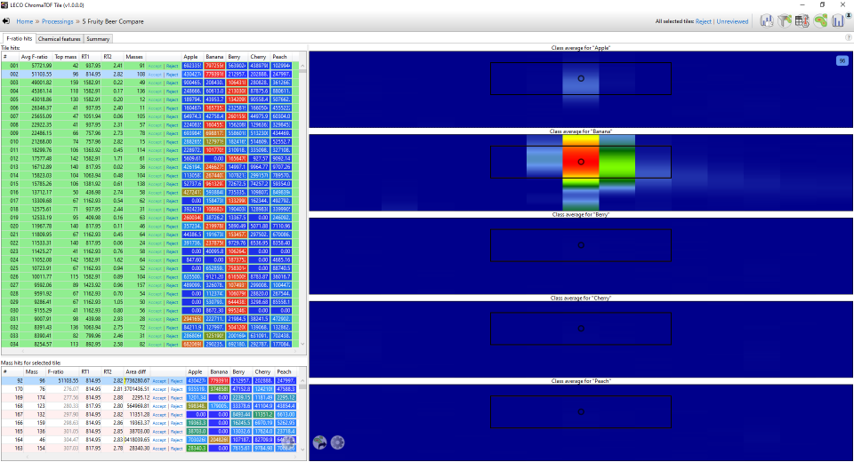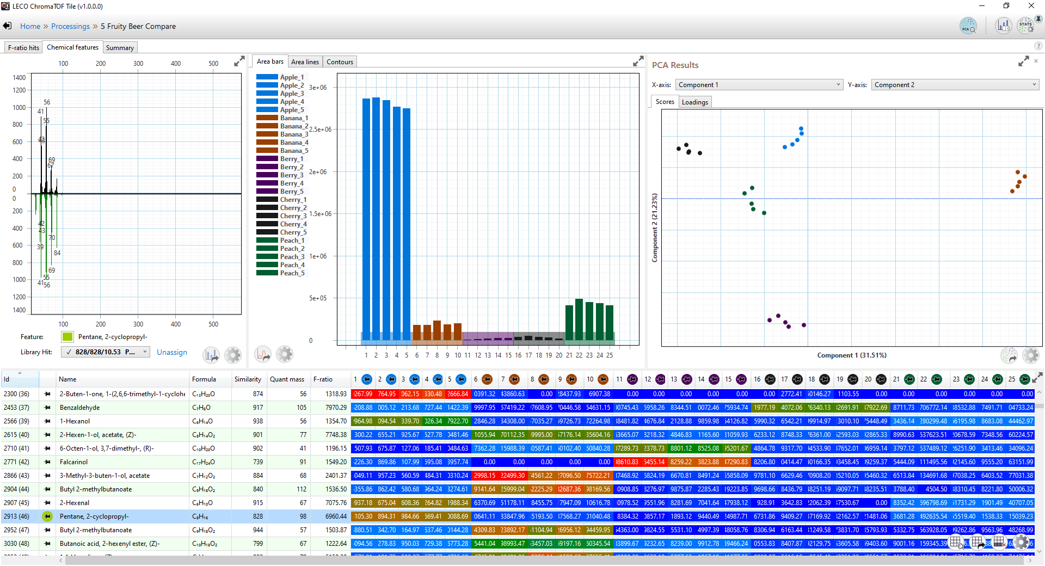ChromaTOF Tile Analytical Software: GCxGC-TOFMS Data Analysis: Turn Your Data into Chemistry
The volume of GCxGC data can quickly become overwhelming. Multiple tables of thousands of analytes can require months of data mining at a pixel level to find the minute differences between data sets, and even those results are plagued with false positives from normal chromatographic variation.
ChromaTOF® Tile revolutionizes how GCxGC data is analyzed. This software compares GCxGC data files quickly and easily. Statistically significant differences rise to the top so you can spend less time finding the differences and more time finding out what they mean.
"ChromaTOF Tile is an enabling technology that has reduced our peak picking time from 10 days to 10 minutes. We are now comparing groups of peak-rich samples from complex studies that would have previously required complicated, custom-built solutions."
Designed for Sample Group Differentiation
Optional heatmap tables are incorporated throughout the interface to give instant feedback on relative intensities. ChromaTOF Tile finds differences between two or more classes of samples, such as: biomarkers distinguishing healthy from not; off-odor detection in food samples that passed or failed quality control; water samples up- and down-stream from an outflow source; petroleum samples from various geographical origins; and anything else you can imagine.
Features
- ChromaTOF Tile is a separate, stand-alone product to be used in conjunction with ChromaTOF brand software.
- All of the tables and plots throughout the interface are exportable for more efficient reporting and to allow you to do more with your data.
- Clean library-searchable spectra is generated from the tiling process.
- Areas of the tiles are used to approximately quantify trends across the samples.
Theory of Operation
The Problem: Comparing sets of chromatograms can be a tedious and lengthy process. With the need to compensate for chromatographic misalignment and count thousands of analytes, even automatic sample identification could take days, weeks, or even months. Our customers asked us to help provide a way to expedite data analysis.
The Solution: Utilizing customer data – real samples – we set out to find a solution. In consultation with Dr. Robert Synovec, we found that if we utilized Fisher Ratios, we could partition the data into a set of regions (‘tiles’) and compare the regionalized (‘tiled’) data, rather than each individual pixel.

After essentially averaging the values in a region, our ChromaTOF Tile software compares two corresponding regions to assess the value of difference between these regions. Presented in a graphical means, the software provides users with indicators of low-to-high variance among regions.
These graphic heatmaps quickly and easily draw users’ eyes to areas of high variance, or high interest, reducing the time you spend looking for data outliers. Visually, you can see where the differences are and know what data you should be looking at for your comparisons.

ChromaTOF Tile does not change the data that is supplied. By comparing tiles instead of pixels, the system can reduce alignment shift flags to better show only the significant differences between the data sets.
ChromaTOF Tile Details
Current ChromaTOF user?
View helpful resources to use and learn the robust GCxGC software.
References
Enhanced GCxGC-TOFMS Biomarker Discovery
Fisher Ratio Analysis GCxGC–TOFMS using Null Distribution Approach
Receiver Operating Characteristic Curve Optimization within GCxGC-TOFMS
Improved Feature Selection Analysis in GCxGC-TOFMS
Chemical Characterization of Acid Alteration of Diesel Fuel
Tile-based Fisher Ratio Analysis using Yeast Metabolome Dataset
Differentiation of Regular and Barrel-Aged Maple Syrups with ChromaTOF Tile [PDF]
ChromaTOF Tile [PDF]
"My research group and I at the University of Washington in Seattle are delighted to see our research come to fruition in the release of ChromaTOF Tile. We anticipate that the GCxGC users community will benefit greatly from this discovery-based data analysis tool to address the many challenges stemming from the supervised analysis of complex data sets."
“With state-of-the-art analytical methods like comprehensive 2D GC-TOF MS it is simple to generate lots of data, but it is only with the ChromaTOF Tile software that we can translate these into meaningful information and knowledge.
“In aerosol science we are commonly interested in the differences between several sets of samples to e.g. compare different sources or atmospheric aging regimes. For this, ChromaTOF Tile has quickly proven to be a very convenient and straight-forward tool for the evaluation of complex GCxGC data.”
“When conducting biomarker discovery studies, biases in your data (e.g., batch effects) can send you down the wrong path. The PCA capabilities of ChromaTOF Tile are a quick and powerful way to see the structure of your data, including inherent biases that they possess. This gives users the opportunity to correct for those biases before or after statistical analyses, making putative biomarkers more robust.”
